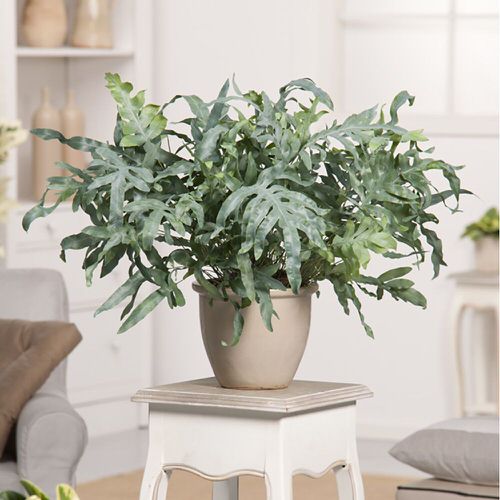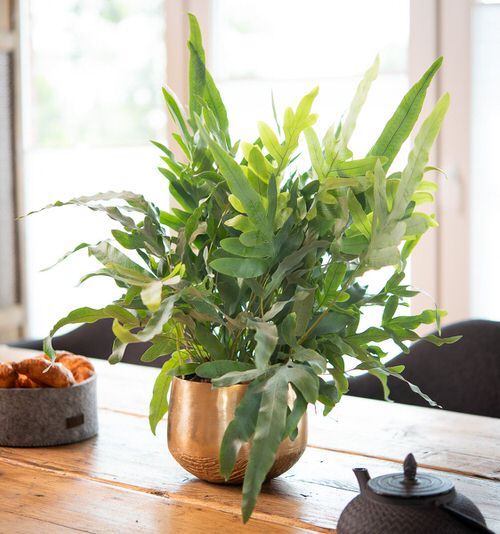Phlebodium aureum is one of the most versatile and distinctive plants in the Fern family! Let’s have a look at how to take Blue Star Fern Care Indoors.

This unique plant is native to the Americas’ tropical and subtropical regions. An interesting fact is it’s an epiphytic fern, which means that it grows on other trees such as dwarf palms and other rainforest plants! If you too want to add it to your plant collection, then here’s everything on Blue Star Fern Care Indoors!
Common Names: Golden Polypody, Hare-Foot Fern, Cabbage Palm Fern, Golden Serpent Fern, Gold Foot Fern
Here’s how to keep your ferns lush and beautiful all year round
Requirements for Growing Blue Star Fern

Even though it is a low-maintenance plant, the care towards your Blue Fern must never go away. These factors will help your plant flourish for a long time to come.
Location
It does best in indirect or filtered light. Avoid placing the plant in direct sun, as too much sunlight falling on fronds will burn them. Placing the plant within 3 feet of a bathroom or a kitchen window is a great idea as it will get the right temperature, light, and humidity for optimum growth.
Soil
Blue Star Ferns are not fond of moist and waterlogged soil because they are epiphyte. You can use your regular houseplant mix for them but make sure it drains well otherwise your plants will suffer from overwatering issues.
A Tip: Don’t house this fern in a growing medium with completely different ingredients than before. For example, if it’s growing in a houseplant potting mix, don’t transfer it into an orchid mix because it’s an epiphyte, during your next repotting session.
Water
Unlike other ferns, this one doesn’t mind living in slightly dry soil. Just water it once a week in the usual months. In winter and during wet weather–Reduce watering. Whereas, in summers, you can increase the frequency.
We have a great article on how to bottom water your houseplants here
Blue Star Fern Care Indoors

Fertilization
The plant will enjoy the nutrients available in the fresh potting mix for the first 6-8 months. So, you don’t have to feed it during that time period. Post that, use a half-strength balanced liquid fertilizer once every 6 to 10 weeks (frequency depends on the growing condition)
A Tip: Avoid feeding the plant in winters or when you see no active growth.
Temperature & Humidity
The plant does well in the temperature range of 61-75° F (16-24°C). Make sure the temperature doesn’t drop below 50°F (10°C).
Like all other ferns, it loves humidity and absolutely thrives in it! House it or over a saucer or tray filled with small pebbles and water. Using a humidifier is also a great idea to ensure the plant gets proper humidity. We also have a great article on how to increase humidity for plants here. Do check it out!
Pruning
Snip away the damaged, diseased, or pest-infested fronds from time to time to keep the plant looking neat. To give it a nice shape, you can also prune away older and unsightly fronds right before its growing season, i.e. in early spring.
Re-Potting
Blue Star Fern does best when it is in a slightly root-bound state. However, if the plant becomes completely rootbound, then re-pot it in one size bigger pot.
Where to Keep Blue Star Fern
With its furry, deeply lobed fronds in blue-green-gray color, the plant can be a star addition to any spot of the room as it does well in dappled sunlight or indirect light. Also, as it grows a maximum of 2-3 feet tall with 1-2 feet spread, a tabletop, cabinet, or a windowsill would be a great choice to display it!
Close Relatives of Blue Star Fern
Virginia Blue fern (Phlebodium pseudoaureum) has green-gray fronds and is quite closely related to the Blue Fern. Calaguala or Samambaia Fern (Phlebodium decumanum) also falls in the same genus.


